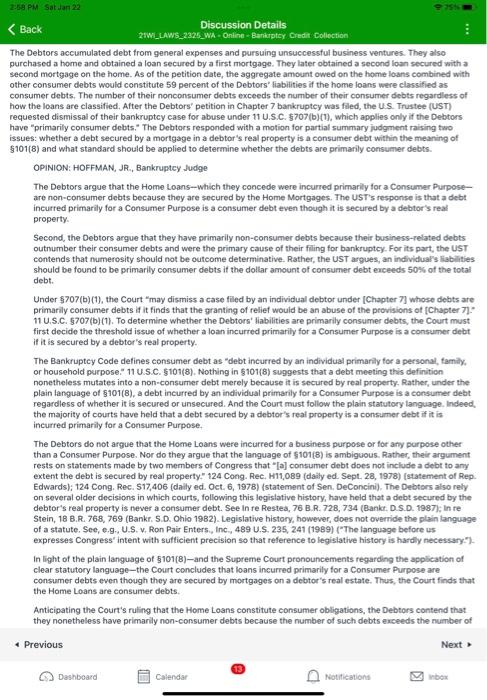Question
The Debtors accumulated debt from general expenses and pursuing unsuccessful business ventures. They also purchased a home and obtained a loan secured by a first
The Debtors accumulated debt from general expenses and pursuing unsuccessful business ventures. They also purchased a home and obtained a loan secured by a first mortgage. They later obtained a second loan secured with a second mortgage on the home. As of the petition date, the aggregate amount owed on the home loans combined with other consumer debts would constitute 59 percent of the Debtors liabilities if the home loans were classified as consumer debts. The number of their nonconsumer debts exceeds the number of their consumer debts regardless of how the loans are classified. After the Debtors petition in Chapter 7 bankruptcy was filed, the U.S. Trustee (UST) requested dismissal of their bankruptcy case for abuse under 11 U.S.C. 707(b)(1), which applies only if the Debtors have primarily consumer debts. The Debtors responded with a motion for partial summary judgment raising two issues: whether a debt secured by a mortgage in a debtors real property is a consumer debt within the meaning of 101(8) and what standard should be applied to determine whether the debts are primarily consumer debts.
OPINION: HOFFMAN, JR., Bankruptcy Judge
The Debtors argue that the Home Loanswhich they concede were incurred primarily for a Consumer Purposeare non-consumer debts because they are secured by the Home Mortgages. The USTs response is that a debt incurred primarily for a Consumer Purpose is a consumer debt even though it is secured by a debtors real property.
Second, the Debtors argue that they have primarily non-consumer debts because their business-related debts outnumber their consumer debts and were the primary cause of their filing for bankruptcy. For its part, the UST contends that numerosity should not be outcome determinative. Rather, the UST argues, an individuals liabilities should be found to be primarily consumer debts if the dollar amount of consumer debt exceeds 50% of the total debt.
Under 707(b)(1), the Court may dismiss a case filed by an individual debtor under [Chapter 7] whose debts are primarily consumer debts if it finds that the granting of relief would be an abuse of the provisions of [Chapter 7]. 11 U.S.C. 707(b)(1). To determine whether the Debtors liabilities are primarily consumer debts, the Court must first decide the threshold issue of whether a loan incurred primarily for a Consumer Purpose is a consumer debt if it is secured by a debtors real property.
The Bankruptcy Code defines consumer debt as debt incurred by an individual primarily for a personal, family, or household purpose. 11 U.S.C. 101(8). Nothing in 101(8) suggests that a debt meeting this definition nonetheless mutates into a non-consumer debt merely because it is secured by real property. Rather, under the plain language of 101(8), a debt incurred by an individual primarily for a Consumer Purpose is a consumer debt regardless of whether it is secured or unsecured. And the Court must follow the plain statutory language. Indeed, the majority of courts have held that a debt secured by a debtors real property is a consumer debt if it is incurred primarily for a Consumer Purpose.
The Debtors do not argue that the Home Loans were incurred for a business purpose or for any purpose other than a Consumer Purpose. Nor do they argue that the language of 101(8) is ambiguous. Rather, their argument rests on statements made by two members of Congress that [a] consumer debt does not include a debt to any extent the debt is secured by real property. 124 Cong. Rec. H11,089 (daily ed. Sept. 28, 1978) (statement of Rep. Edwards); 124 Cong. Rec. S17,406 (daily ed. Oct. 6, 1978) (statement of Sen. DeConcini). The Debtors also rely on several older decisions in which courts, following this legislative history, have held that a debt secured by the debtors real property is never a consumer debt. See In re Restea, 76 B.R. 728, 734 (Bankr. D.S.D. 1987); In re Stein, 18 B.R. 768, 769 (Bankr. S.D. Ohio 1982). Legislative history, however, does not override the plain language of a statute. See, e.g., U.S. v. Ron Pair Enters., Inc., 489 U.S. 235, 241 (1989) (The language before us expresses Congress intent with sufficient precision so that reference to legislative history is hardly necessary.).
In light of the plain language of 101(8)and the Supreme Court pronouncements regarding the application of clear statutory languagethe Court concludes that loans incurred primarily for a Consumer Purpose are consumer debts even though they are secured by mortgages on a debtors real estate. Thus, the Court finds that the Home Loans are consumer debts.
Anticipating the Courts ruling that the Home Loans constitute consumer obligations, the Debtors contend that they nonetheless have primarily non-consumer debts because the number of such debts exceeds the number of their consumer liabilities. Taking the contrary position, the UST argues that the Debtors have primarily consumer debts because the aggregate dollar amount of their consumer debt exceeds 50% of their total liabilities.
Courts have interpreted the phrase primarily consumer debts in several different ways. The majority view is that a debtors liabilities are primarily consumer debts if the aggregate dollar amount of such debts exceeds 50% of the debtors total liabilities.
There are a number of minority approaches. Some courts consider the relative dollar amount of consumer and non-consumer debt and, if those amounts are approximately equal, the number of consumer and non-consumer debts as well. See In re Bell, 65 B.R. 575, 577-78 (Bankr. E.D. Mich. 1986). Other courts hold that a debtor has primarily consumer debts only if the dollar amount of such debts exceeds 50% of the debtors total liabilities and the consumer debts outnumber the non-consumer debts. See In re Vianese, 192 B.R. 61, 68 (Bankr. N.D.N.Y. 1996). Still other courts hold that a debtor has primarily consumer debts only if the amount of consumer debt actually being discharged and not reaffirmed exceeds 50% of the debtors total liabilities. See Restea, 76 B.R. at 734.
[The court concludes it cannot find that the meaning of the phrase primarily consumer debts as used in 707(b)(1) is unambiguous and must look to legislative history, policy rationales, and the context in which the statute was passed.]
In summarizing the context in which 707(b)(1) was passed, and the policy rationale motivating its enactment, the Sixth Circuit has explained:
Section 707(b) was among the consumer credit amendments to the Bankruptcy Code enacted in 1984. These amendments were passed in response to an increasing number of Chapter 7 bankruptcies filed each year by non-needy debtors.
Under prior practice, aside from potential 523(a) exceptions, 707(a) dismissals, and 727(a) objections to discharge, debtors enjoyed an unfettered right to a fresh start under Chapter 7, in exchange for liquidating their nonexempt assets for the benefit of their creditors. Section 707(b) introduces an additional restraint upon a debtors ability to attain Chapter 7 relief. Bankruptcy judges now have discretion to dismiss a consumer case when the filing is abusive.
In essence, 707(b) allows a bankruptcy court to deal equitably with the unusual situation where an unscrupulous debtor seeks to enlist the courts assistance in a scheme to take unfair advantage of his creditors; it serves notice upon those tempted by unprincipled accumulation of consumer debt that they will be held to at least a rudimentary standard of fair play and honorable dealing.
In re Krohn, 886 F.2d 123, 125-26 (6th Cir. 1989). In short, 707(b)(1) was passed in part to protect creditors against abusive Chapter 7 filings.
Based on the context in which 707(b)(1) was passed and the policy concerns it was intended to address, the Court adopts the majority view and concludes that a debtor has primarily consumer debts if the aggregate amount of his or her consumer debt exceeds 50% of the total debt. To hold otherwise and determine the primary nature of debts based on the relative number of consumer versus non-consumer obligations could lend itself to pre-bankruptcy manipulation. For example, a debtor with total consumer debts of $50,000 owed on five credit cards could attempt to avoid 707(b)(1)s abuse analysis by consolidating the $50,000 of debt onto one credit card, leaving the debtor with only one consumer debt to weigh against a larger number, but lesser amount, of non-consumer debts. If this same debtor owes several small tax debts to multiple taxing authoritieswhich the Sixth Circuit has held is non-consumer debt, . . . then the debtor would have a greater number of non-consumer debts than consumer debts. If a bankruptcy court were to determine the nature of the debts based on numerosity, then the debtor would not be subject to scrutiny under 707(b)(1)contrary, it would seem, to Congresss aim of addressing the perceived abuse of Chapter 7. By contrast, if the primary nature of a debtors liabilities is measured by the relative amount of debt, then a prospective debtor planning ahead to avoid a Chapter 7 dismissal might do so by paying down consumer debt, consistent with the policies behind 707(b)(1).
For these reasons, the Court concludes that the appropriate method for ascertaining 707(b)(1)s applicability is to determine whether the aggregate amount of a debtors consumer debt exceeds 50% of his/her total liabilities. If so, then 707(b)(1) applies. Application of this methodology here leads to the inescapable conclusion that the Debtors obligations are primarily consumer debts.
For the foregoing reasons, the Court holds that a loan incurred primarily for a Consumer Purpose is a consumer debt even if it is secured by a mortgage on a debtors real property. The Court also concludes that a debtor has primarily consumer debts if the aggregate amount of consumer debt exceeds 50% of the total debt. . . .
Topic Questions:
- What were the debtors trying to avoid by arguing that their home mortgage was not a consumer debt?
- Would the result in Hlavin have been different if the loans secured by the debtors home had originally been taken out to fund a failed business venture? What if they had been taken out for home improvement or a vacation but then actually used to fund a business venture? Would it matter if they told the bank the money was being borrowed for home improvement or vacation but intended it to be used to fund a business venture? What if the home loans had been taken out for mixed personal/business reasons?
- If the debtors in Hlavin had 30 different consumer debts totaling $75,000 and only one business debt totaling $76,000, would that court find that they had primarily consumer debts under 707(b)(1)? What would be the result if a court utilized one of the alternative approaches to this question mentioned in Hlavin?
Reflection Questions:
- What specific knowledge and information did you gain from the learning materials and activities that you can apply to your experiences now? In the future?
- What are the social and ethical issues involved with the subject matter of this assignment?
- Which topics were confusing, complicated or contradictory? Why? Did you ask the class or instructor for assistance?

Step by Step Solution
There are 3 Steps involved in it
Step: 1

Get Instant Access to Expert-Tailored Solutions
See step-by-step solutions with expert insights and AI powered tools for academic success
Step: 2

Step: 3

Ace Your Homework with AI
Get the answers you need in no time with our AI-driven, step-by-step assistance
Get Started


